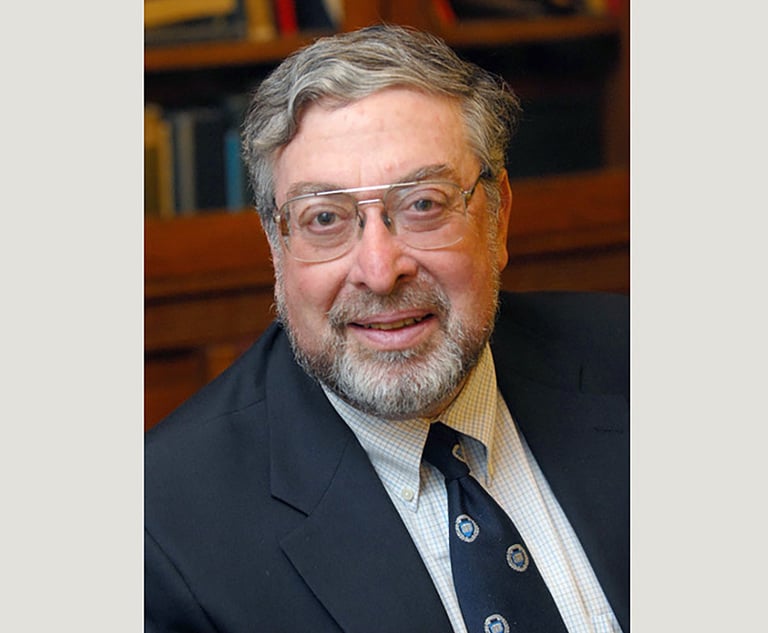Considering the Rights of a Misidentified Surrogate Child
How should the law decide a case in which a surrogate mother has given birth to two children, only one of whom was the product of in vitro fertilization by the contractual donor?
December 21, 2017 at 02:09 PM
5 minute read
 How should the law decide a case in which a surrogate mother has given birth to two children, only one of whom was the product of in vitro fertilization by the contractual donor? This situation arose recently after a surrogate mother who was pregnant with the child of Chinese donor parents also became pregnant at the same time with a biological child of herself and her partner, resulting from a very rare occurrence known as “superfetation.” This case adds yet one more chapter in a long history of cases involving the rights of biological parents, nonbiological third parties and donors, and surrogate parents. In this particular instance, we believe the rights of the child should be given full recognition.
How should the law decide a case in which a surrogate mother has given birth to two children, only one of whom was the product of in vitro fertilization by the contractual donor? This situation arose recently after a surrogate mother who was pregnant with the child of Chinese donor parents also became pregnant at the same time with a biological child of herself and her partner, resulting from a very rare occurrence known as “superfetation.” This case adds yet one more chapter in a long history of cases involving the rights of biological parents, nonbiological third parties and donors, and surrogate parents. In this particular instance, we believe the rights of the child should be given full recognition.
In terms of the surrogacy aspect of the case, the facts are not remarkable. After a mother of two children decided to become a surrogate mother, she entered into a legally valid contract with a private agency. As a result of an in vitro procedure, she thereafter became pregnant with the child of a Chinese donor parent. During the pregnancy, it was discovered that she was actually carrying two children, and she was paid additional compensation based on the assumption that the two “twins” were the product of the in vitro fertilization procedure.
After the two children were born and the mother saw cellphone pictures of the two babies, it was quite apparent that the two children were not “twins.” Yet by that time, the children were in the custody and care of the donor parents. During the legal dispute that followed, DNA test results conclusively established that one of the children was, in fact, the biological child of the mother and her partner. In other words, that child was a “mistaken” surrogate child. Eventually, the donor parents relinquished custody of the child to the agency. But instead of immediately giving the child to the biological parents, it was reported that the agency took steps toward offering the child for adoption. In the end, the child ended up in the care and custody of the biological parents. But based on reporting of this incident, the stress, expense and difficulty of this conflict perhaps could have been minimized or avoided if everyone involved had a better understanding of the underlying legal principles.
Ordinarily, the U.S. Supreme Court leaves divorce and family law matters such as custody and visitation to the states. But the court has nevertheless involved itself extensively in matters pertaining to the constitutional rights of biological parents. For example, in the seminal case of Troxel v. Granville, 530 U.S. 57 (2000), when the court was faced with the competing interests of biological parents and grandparents, the court leaned heavily in favor of the fundamental constitutional rights of biological parents to the care, custody and control of their own child. Following Troxel, the Connecticut Supreme Court likewise arrived at a similar result in Roth v. Weston, 259 Conn. 202 (2002). In these cases, however, both the U.S. and Connecticut supreme courts have noted that the usual “best interest of the child” standard is “secondary to the parent's rights.” Roth v. Weston, 259 Conn. at 222. The emphasis of the law has thus focused on the rights of the biological parent particularly in cases where there are questions regarding the extent of the child's relationship with a nonparent.
In a case where a child born to a surrogate mother is only “mistakenly” a surrogate child, it seems obvious that the focus of legal analysis should unequivocally be on the interests of both the biological parents and their biological child. In the case in question, therefore, a donor parent has valid contractual and legal rights to the care and custody of both children only if they were indeed conceived as a result of in vitro fertilization. Once it has been established that one of those children was actually the biological child of the surrogate mother, the legal analysis should focus clearly and unmistakably on the interests of both the biological mother and her biological child.
This conclusion is supported by the U.S. Supreme Court's decisions in Santosky v. Kramer, 455 U.S. 745 (1982), and Stanley v. Illinois, 405 U.S. 645 (1972), which recognize that the interests of parents and children are “reciprocal.” Similarly, our Supreme Court has also had occasion to recognize the “reciprocal” interests of a parent and child as noted in In Re Juvenile Appeal 83-CD, 189 Conn. 276 (1983). In a dissenting opinion in Troxel, Justice John Paul Stevens commented that the U.S. Supreme Court “has not yet had the occasion to elucidate the nature of a child's liberty interests in preserving established familial or family-like bonds … [however,] … to the extent parents and families have fundamental liberty interests in preserving such intimate relationships, so too do children have those interests, and so too must their interests be balanced in the equation.”
Applying these legal principles to a case where two children are born of a surrogate mother, only one of whom is an actual “surrogate” child, once it is established as an indisputable fact that one child is the biological child of the surrogate mother, everyone involved would be spared needless stress, expense, uncertainty and turmoil if the legal/contractual aspect of the dispute were disregarded in favor of immediately recognizing and enforcing the reciprocal fundamental constitutional interests of the biological parents and child.
This content has been archived. It is available through our partners, LexisNexis® and Bloomberg Law.
To view this content, please continue to their sites.
Not a Lexis Subscriber?
Subscribe Now
Not a Bloomberg Law Subscriber?
Subscribe Now
NOT FOR REPRINT
© 2025 ALM Global, LLC, All Rights Reserved. Request academic re-use from www.copyright.com. All other uses, submit a request to [email protected]. For more information visit Asset & Logo Licensing.
You Might Like
View All
Special Series Part 4: The Statutory Guardrails Impermissibly Bind Future Legislatures

The Appropriate Exemption in Students for Fair Admissions v. President & Fellows of Harvard College
4 minute read
Special Series Part 1: Are Connecticut’s Budget Guardrails Constitutional?

French Rape Case Highlights Need for Vigilance, Education
Trending Stories
- 1Thinking Outside the RFP: AI’s Impact Beyond Scaling Review Efficiency
- 2Special Series Part 4: The Statutory Guardrails Impermissibly Bind Future Legislatures
- 3New York Court of Appeals Blocks Trump Attempt to Stay Friday Sentencing
- 4'Self-Diagnosed Nickel Allergy' Fails to Find Success in Med-Mal Suit, 8th Circuit Rules
- 5Eversheds Sutherland Adds Hunton Andrews Energy Lawyer With Cross-Border Experience
Who Got The Work
Michael G. Bongiorno, Andrew Scott Dulberg and Elizabeth E. Driscoll from Wilmer Cutler Pickering Hale and Dorr have stepped in to represent Symbotic Inc., an A.I.-enabled technology platform that focuses on increasing supply chain efficiency, and other defendants in a pending shareholder derivative lawsuit. The case, filed Oct. 2 in Massachusetts District Court by the Brown Law Firm on behalf of Stephen Austen, accuses certain officers and directors of misleading investors in regard to Symbotic's potential for margin growth by failing to disclose that the company was not equipped to timely deploy its systems or manage expenses through project delays. The case, assigned to U.S. District Judge Nathaniel M. Gorton, is 1:24-cv-12522, Austen v. Cohen et al.
Who Got The Work
Edmund Polubinski and Marie Killmond of Davis Polk & Wardwell have entered appearances for data platform software development company MongoDB and other defendants in a pending shareholder derivative lawsuit. The action, filed Oct. 7 in New York Southern District Court by the Brown Law Firm, accuses the company's directors and/or officers of falsely expressing confidence in the company’s restructuring of its sales incentive plan and downplaying the severity of decreases in its upfront commitments. The case is 1:24-cv-07594, Roy v. Ittycheria et al.
Who Got The Work
Amy O. Bruchs and Kurt F. Ellison of Michael Best & Friedrich have entered appearances for Epic Systems Corp. in a pending employment discrimination lawsuit. The suit was filed Sept. 7 in Wisconsin Western District Court by Levine Eisberner LLC and Siri & Glimstad on behalf of a project manager who claims that he was wrongfully terminated after applying for a religious exemption to the defendant's COVID-19 vaccine mandate. The case, assigned to U.S. Magistrate Judge Anita Marie Boor, is 3:24-cv-00630, Secker, Nathan v. Epic Systems Corporation.
Who Got The Work
David X. Sullivan, Thomas J. Finn and Gregory A. Hall from McCarter & English have entered appearances for Sunrun Installation Services in a pending civil rights lawsuit. The complaint was filed Sept. 4 in Connecticut District Court by attorney Robert M. Berke on behalf of former employee George Edward Steins, who was arrested and charged with employing an unregistered home improvement salesperson. The complaint alleges that had Sunrun informed the Connecticut Department of Consumer Protection that the plaintiff's employment had ended in 2017 and that he no longer held Sunrun's home improvement contractor license, he would not have been hit with charges, which were dismissed in May 2024. The case, assigned to U.S. District Judge Jeffrey A. Meyer, is 3:24-cv-01423, Steins v. Sunrun, Inc. et al.
Who Got The Work
Greenberg Traurig shareholder Joshua L. Raskin has entered an appearance for boohoo.com UK Ltd. in a pending patent infringement lawsuit. The suit, filed Sept. 3 in Texas Eastern District Court by Rozier Hardt McDonough on behalf of Alto Dynamics, asserts five patents related to an online shopping platform. The case, assigned to U.S. District Judge Rodney Gilstrap, is 2:24-cv-00719, Alto Dynamics, LLC v. boohoo.com UK Limited.
Featured Firms
Law Offices of Gary Martin Hays & Associates, P.C.
(470) 294-1674
Law Offices of Mark E. Salomone
(857) 444-6468
Smith & Hassler
(713) 739-1250










